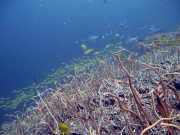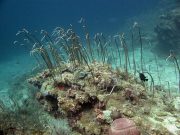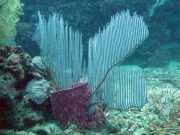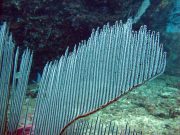Tauchen mit Peitschenkorallen
Meeresleben von Lanta | Ellisellidae
Peitschenkorallen wachsen überall in der südlichen Andamanensee, auch im Klong (Kanal), der Lanta Yai von Lanta Noi trennt. Beim Tauchen von Koh Lanta aus können Sie diese Weichkorallen nicht übersehen.
Wie die anderen Weichkorallen sind auch die Ellisellidae eine Familie von Peitschenkorallen, die kein Kalziumkarbonat-Skelett bilden. Stattdessen haben diese Korallen flexible Skelette, die aus einem komplexen Protein namens Gorgonin bestehen.
Each gorgonian polyp has eight tentacles which catch plankton and particulate matter passing in the currents. This family are recognised by their typical colony formation, which generally grow or branch upward.
2 Arten auf dieser Seite gefunden:
Sea Whip Coral
(Junceella fragilis)
Sea whip coral colonies grow vertically, up to 2m in length and are unbranched, with their upper third twisted or bent. The unbranched main axis is heavily calcified. The colony stem is white to brownish, densely covered with small polyps and containing zooxanthellae, which are responsible for the nutrition of the colony.
These corals are found in reef areas exposed to strong currents in deeper water or reef flats, reef slopes and flat coral rock.

Junceella fragilis @ Koh Haa
The colonies reproduce asexually; the upper end of a colony is shed and grows into a new whip-like coral. This results in very dense fields of these corals where thousands of colonies settle very close together.

Sea Whip Coral @ Koh Haa
The bivalve Pteria brevialata and gobies on the genus Bryaninops are found living symbiotically together with these corals. Brittle stars often climb up on to these gorgonians to use their exposed position to collect food from the current.
Lyre Sea Fan
(Ctenocella pectinata)

Ctenocella pectinata @ Koh Phi Phi
The Lyre Sea Fan, Harp Sea Fan or Red Whip Coral, has a distinctive comb-like shape, with many parallel branches growing vertically upward from the main stems.
The branches are of variable length and resemble the teeth of a comb.

Lyre Sea Fan with vertical, comb-like branches
The main stem is a deep red to brownish colour, with numerous while polyps on the vertical secondary branches. When the polyps are retracted, they form small lumps on the otherwise smooth stem.

Lyre Sea Fan Coral polyps are white
Lyre Sea Fan corals can grow more than 1 metre in height, with secondary branches reaching 60 - 70 cm in length.
This soft coral is found in areas with mild to medium current, between 10 m and 30 m, often close to other species of whip corals and sea fans.
Tauchen mit Peitschenkorallen rund um Koh Lanta
Tauch- und Schnorchelausflüge
Wenn Sie gerne die Gelegenheit hätten, Peitschenkorallen auf einem unserer täglichen Tauchausflüge während der Hochsaison von Koh Lanta aus zu sehen, dann senden Sie uns eine E-Mail an info@diveandrelax.com.
Nehmen Sie an unseren Speedboot-Tauchausflügen in der Hochsaison zu einigen der besten Tauchplätze Thailands teil und genießen Sie kleine Gruppen, kurze Fahrzeiten und einen Fokus auf hervorragenden persönlichen Service, Sicherheit und Spaß.
Noch kein zertifizierter Taucher? Lernen Sie auf Koh Lanta das Tauchen mit dem 3-tägigen SSI Open Water Diver Kurs.
Buchen Sie online und sparen Sie 10% auf Tauchausflüge und Tauchkurse auf Koh Lanta.
Weitere Informationen
Indo-Pazifische Meereslebewesen-Führer
- Allen, G., Steene, R., Humann, P., DeLoach, N. (2003) Reef Fish Identification, Tropical Pacific. Jacksonville, FL., USA: New World Publications, Inc., ISBN 1-878348-36-1.
- Humann, P., DeLoach, N., (2010) Reef Creature Identification, Tropical Pacific. Jacksonville, FL., USA: New World Publications Inc., ISBN 978-1-878348-44-9
- Debelius, H. (2013) Indian Ocean Reef Guide. Frankfurt, Germany: IKAN - Unterwasserarchiv, ISBN 978-3-939767-52-7.
- Debelius, H. (2004) Nudibranchs and Sea Snails, Indo-Pacific Field Guide. Frankfurt, Germany: IKAN - Unterwasserarchiv, ISBN 3-925919-51-1
- Erhardt, H., Knop, D. (2015) Corals Indo-Pacific Field Guide. Frankfurt, Germany: IKAN - Unterwasserarchiv, ISBN 3-925919-69-4.
- Veron J.E.N., Stafford-Smith M.G., Turak E. and DeVantier L.M. (2016). Corals of the World
Weitere Referenzen zu Meereslebewesen und weitere Informationen
